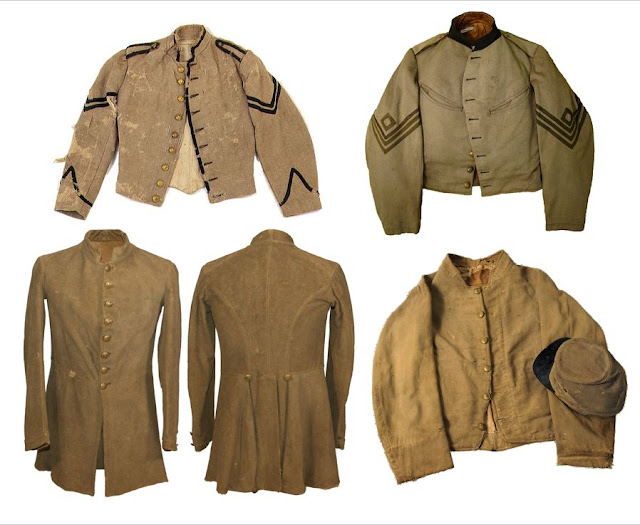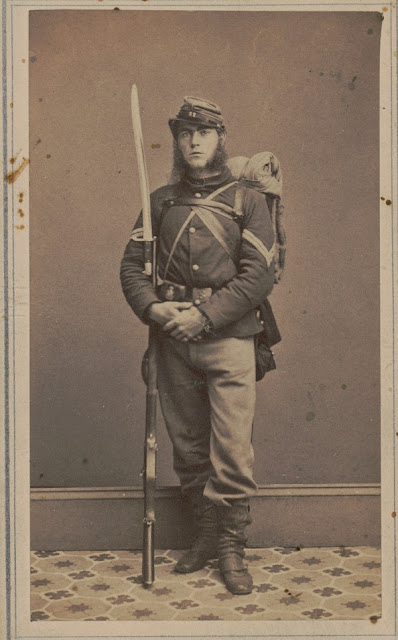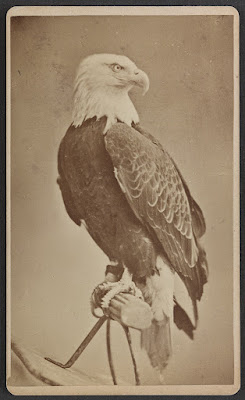Death by Mismanagement: With the 1st Michigan at First Bull Run
Charging against Stonewall Jackson’s Virginians on Henry House Hill on July 21, 1861, Private Solomon Holben of the 1st Michigan recalled the back-and-forth charges aimed at seizing that vital piece of ground.
“We charged on the run, shouting “Remember Fort
Sumter!” When we got to the top of the hill, we halted and fired. The Rebels
were mowed down like grass and in a few minutes not one of them was left in
sight. Their masked batteries poured in a perfect shower of cannon balls among
us. An order was given by one of our captains (acting as major) to retreat;
about one-third of the men left the battlefield when the captain was pulled
from his horse and another took his place,” he wrote.
“We then charged over the hill a second time but
there was no order this time as every man fought for himself, every Rebel was
driven in, but the masked batteries kept up a continual fire. We fell back a
second time, charged again, but this time our other color bearer was shot down.
We fell back and charged over the hill four times; the last time I ran
alongside Colonel Willcox as no one else was near him. An order was given to
retreat for we were nearly hemmed in on all sides and but one other regiment
was supporting us. Colonel Wilcox had two horses shot under him and I saw the
first one fall.”
Private Holben’s account of First Bull Run, a letter written to his brother and sister in Angola, Indiana, first saw publication in the August 3, 1861, edition of the local newspaper, the Steuben Republican. During this campaign, the 1st Michigan’s colonel Orlando B. Willcox led the Second Brigade of Colonel Samuel P. Heintzelman’s Third Division; subsequently, the 1st Michigan was led by Major Alonzo F. Bidwell. Special thanks to friend of the blog Harry Smeltzer and John Hennessey.
 |
| This George Barnard image dating from March 1862 depicts the ruins of Mrs. Henry's House atop Henry House Hill. The 1st Michigan went into action in this vicinity during the afternoon of July 21, 1861, contesting for control of the hill with a stalwart brigade of Virginians under the command of Thomas J. Jackson, who earned his nickname of "Stonewall" Jackson for his determined stand here. The 1st Michigan lost 15 killed, 41 wounded, and 61 captured or missing for a total of 117. (Metropolitan Museum of New York) |
July 24, 1861
Dear
brother and sister,
I seat myself once more to write a few lines to
inform you that I am alive but I got back here I can hardly tell. I was at the
great battle at Bull Run on last Sunday. I will give an account of our doings
since we left Cloud’s Mill. About 33,000 men under General [Irvin] McDowell
(among whom was our regiment) marched to Fairfax Courthouse and Fairfax
Station; our company (Coldwater) was marched ahead of the brigade and employed
as skirmishers and were marched through the woods three miles to the station
where we arrived and halted an hour before the enemy came in sight.
About 2,100 Alabama troops were drawn up in line
of battle but they broke and ran as soon as we came in sight. We took 11
prisoners and marched them up to Colonel Willcox just as he came up at the head
of the Fire Zouaves. Fairfax Courthouse was taken on the same day. We were
there two days with nothing but the sky to cover us. We then marched to
Centreville, about 18 miles from Bull Run where we stayed a few days more.
About 12 o’clock on Sunday morning we were
ordered out and at about 3 everything was ready and the march commenced. There
were in all 45,000 men under McDowell. The battle commenced in the morning; we
could hear the cannonading shortly after we started. When we got within 7-8 miles,
we could hear the musketry and see the smoke. We arrived on the field about 2 o’clock.
General McDowell rode up to our colonel and ordered his to lead his men to the
support of the left wing under Colonel [Samuel P.] Heintzelman and attack the
enemy. We started for our position.
 |
| This set of silk regimental colors was carried by the 1st Michigan Infantry at First Bull Run and captured. During the course of the fighting, both color bearers were struck down but the regiment brought the national colors safely from the field.. The flag features elements of the state flag of Michigan with a ribbon for "1st Regt. Infty." The motto Tuebor on the state shield is Latin for 'I will defend." (Michigan Battle Flags) |
Our artillery had got out of ammunition and were
retreating as were the Fire Zouaves [11th New York] who were cut to
pieces by the Rebels’ masked batteries. Our cavalry was also retreating. When
we got to the place which was occupied by our artillery, a bomb shell discharged
from the masked batteries struck the ground about four rods from us and
exploded. One of the balls struck our color bearer and killed him; it also
killed one of the color guards and knocked down five of our boys. I was in the
same platoon and the ball passed about two feet over my head.
 |
| Captain William H. Withington Co. B, 1st Michigan Wounded and captured at Bull Run Awarded Medal of Honor (Dale Niesen Collection) |
We were marched on a few rods further and were
ordered to charge over a hill; the secessionists were on the other side while
in the woods on the Rebels’ left was one of their masked batteries. We charged
on the run, shouting “Remember Fort Sumter!” When we got to the top of the
hill, we halted and fired. The Rebels were mowed down like grass and in a few
minutes not one of them was left in sight. I saw 5 Massachusetts men; they told
us that they were held as prisoners by the Rebels when our regiment made the
first charge and said that we must have killed or wounded about 300 at the
first fire.
Their masked batteries poured in a perfect shower of cannon balls among us. An order was given by one of our captains (acting as major) to retreat; about one-third of the men left the battlefield when the captain was pulled from his horse and another took his place. We then charged over the hill a second time but there was no order this time as every man fought for himself, every Rebel was driven in, but the masked batteries kept up a continual fire. We fell back a second time, charged again, but this time our other color bearer was shot down.
 |
| Colonel Orlando Bolivar Willcox, a 38 year old West Point graduate and Mexican War veteran, resigned from the army in 1857 but was tapped to lead the 1st Michigan when it entered the service in April 1861. His Regular Army bonafides led to brigade command at First Bull Run where he was wounded in the leg, captured, and eventually in 1895, awarded the Medal of Honor in recognition for his valor upon that field. He ended the war as a brevet major general and served ably in divisional command with the Army of the Potomac following his exchange in August 1862. After the war, he briefly returned to civilian life before again donning the blue uniform for service in the U.S. Army, serving in various commands until his mandatory retirement in 1887 at age 64. (Library of Congress) |
When I left the hill I could see but one of our
boys behind me. About 20 of us went into the woods on the opposite side of the
batteries; the Rebels poured in a perfect shower of musketry after us. When I
got on the lower end of the woods near where we first started on the charge, a
regiment of Rebels came up on the other side. We all threw ourselves into the
ditch and they fired over us. We then jumped up and got into another woods
before they could fire again.
We then got into a field which was filled with
stragglers going back to the main body of the army. The enemy brought a field
piece onto a hill behind us and commenced firing, but they did not hit anyone.
There were but from 25,000 of our troops in the fight; from prisoners we learn
that there were 70,000 Rebels and reinforcements arriving all the time. From
their wounded we learned that three of their men had been killed to one of
ours. I could see their bodies lying in heaps before their batteries. Two of
our captains are killed and a number wounded.
 |
| Co. C styled themselves the Coldwater Cadets and were led by Captain Ebenezer Butterworth pictured above. Wounded and captured during the fighting near Ricketts' Battery at Bull Run, the 33-year-old English-born clothier died of his wounds August 17, 1861, at Charlottesville, Virginia. He left a widow and three young children back in Coldwater, Michigan. (Courtesy of Jeff Joyce, Find-A-Grave) |
Our regiment was the last to leave the field. The
whole army retreated to Fairfax Courthouse and Vienna. I went to Vienna which
was about 25 miles from the battlefield. I lay down twice and slept by the side
of the road. I got lost in the woods and did not get back to the main body for
a long while. Two batteries of artillery were taken by the enemy but we
re-taken in the morning. Cannons, guns, wagons, horses, and wounded men were
strung all along the road from Bull Run to Vienna.
I got a ride from Vienna to Alexandria yesterday
and we were marched from there to Washington. President Lincoln overtook us on
the way; he told us to hurry up and recruit again so as to be ready to march.
The battle was not to have taken place till Tuesday when we were to be supported
by Generals McClellan, Butler, and Patterson with 80,000 more men. Instead of
this, General McDowell wanted to do it alone. We met 10,000 of our men at
Centreville that should have been in the fight.
It was mismanagement that lost us the day more than anything else. General McDowell sent in one regiment after another to be cut to pieces by their masked batteries. There were five times our number of men on the hill when we made the first charge and we drove them all off the field. Our time is out today; I do not know what they will do with us. I heard that we were to be kept 30 days longer. As far as I am concerned, I do not care. I know we can whip the Rebels two to one if we have the right men to lead us.
Yours
truly,
Sol. Holben
For another perspective from the 1st Michigan, please check out a letter from Private Charles Farrand of Co. F available here as featured on Harry's incredible blog "Bull Runnings" devoted to First Bull Run/Manassas. The home for that site can be viewed here.
To learn more about First Bull Run, please check out these other posts:
Source:
Letter
from Private Solomon Holben, Company C "Coldwater Cadets", 1st Michigan Infantry, Steuben
Republican (Indiana), August 3, 1861, pg. 2; Holben later served in Battery D of the 1st Michigan Light Artillery which served in the western theater with the Army of the Cumberland.










Comments
Post a Comment